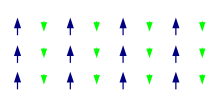Derivation
There are various ways to describe ferrimagnets, the simplest of which is with mean-field theory. In mean-field theory the field acting on the atoms can be written as:

Where  is the applied magnetic field and
is the applied magnetic field and  is field caused by the interactions between the atoms. The following assumption then is:
is field caused by the interactions between the atoms. The following assumption then is:
Here  is the average magnetization of the lattice and
is the average magnetization of the lattice and  is the molecular field coefficient. When we allow
is the molecular field coefficient. When we allow  and
and  to be position and orientation dependent we can then write it in the form:
to be position and orientation dependent we can then write it in the form:

Here  is the field acting on the ith substructure and
is the field acting on the ith substructure and  is the molecular field coefficient between the ith and the kth substructure. For a diatomic lattice we can designate two types of sites, A and B. We can designate
is the molecular field coefficient between the ith and the kth substructure. For a diatomic lattice we can designate two types of sites, A and B. We can designate  the number of magnetic ions per unit volume,
the number of magnetic ions per unit volume,  the fraction of the magnetic ions on the A sites, and
the fraction of the magnetic ions on the A sites, and  the fraction on the B sites. This then gives:
the fraction on the B sites. This then gives:

It can be shown that  and that
and that  unless the structures are identical.
unless the structures are identical.  favors a parallel alignment of
favors a parallel alignment of  and
and  , while
, while  favors an anti-parallel alignment. For ferrimagnets,
favors an anti-parallel alignment. For ferrimagnets,  , so it will be convenient to take
, so it will be convenient to take  as a positive quantity and write the minus sign explicitly in front of it. For the total fields on A and B this then gives:
as a positive quantity and write the minus sign explicitly in front of it. For the total fields on A and B this then gives:


Furthermore, we will introduce the parameters  and
and  which give the ratio between the strengths of the interactions. At last we will introduce the reduced magnetizations:
which give the ratio between the strengths of the interactions. At last we will introduce the reduced magnetizations:


with  the spin of the ith element. This then gives for the fields:
the spin of the ith element. This then gives for the fields:


The solutions to these equations (omitted here) are then given by


where  is the Brillouin function. The simplest case to solve now is
is the Brillouin function. The simplest case to solve now is  . Since
. Since  . This then gives the following pair of equations:
. This then gives the following pair of equations:


with  and
and  . These equations do not have a known analytical solution, so they must be solved numerically to find the temperature dependence of
. These equations do not have a known analytical solution, so they must be solved numerically to find the temperature dependence of  .
.
















































